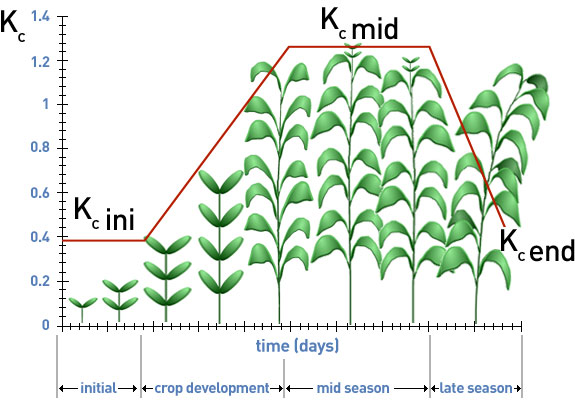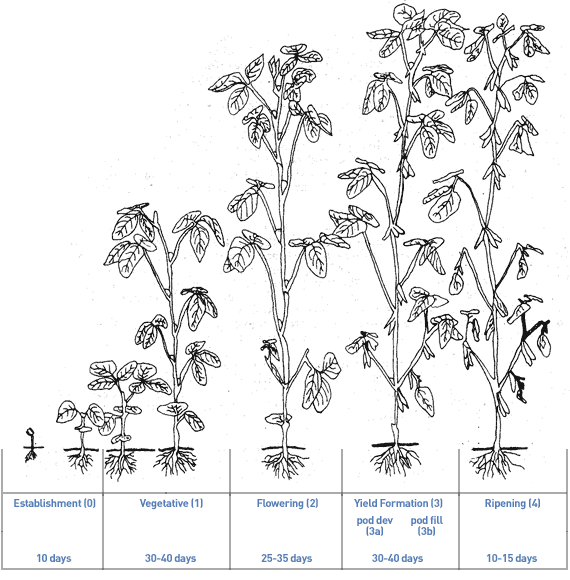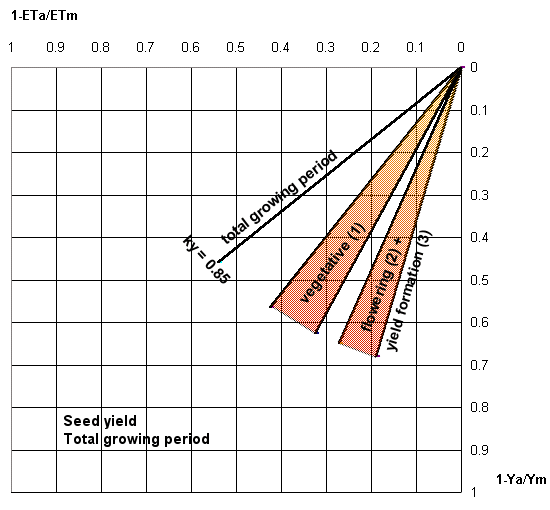Soybean
This section presents information on water relations and water management of soybean and provides links to other sources of information.
Crop Description and Climate
Crop Description and Climate
Soybean (Glycine max) is one of the most important world crops and is grown for oil and protein. Present world production is about 176.6 million tons of beans over 75.5 million ha. The crop is mainly grown under rainfed conditions but irrigation, specifically supplemental irrigation, is increasingly used. (FAOSTAT, 2001).
The crop is grown under warm conditions in the tropics, subtropics and temperate climates. Soybean is relatively resistant to low and very high temperatures but growth rates decrease above 35°C and below 18°C. In some varieties, flowering may be delaXed at temperatures below 24°C. Minimum temp-eratures for growth are about 10°C and for crop production about 15°C. Only 25 to 30 percent of the flowers produce set pods, the final number depending on the plant vigour during the flowering period. Year to year temperature variations can lead to differences in flowering.
Soybean is basically a short-day plant, but response to daylength varies with variety and temperature and developed varieties are adapted only to rather narrow latitude differences. Daylength has an influence on the rate of development of the crop; in short-day types, increased daylength may result in the delay of flowering and taller plants with more nodes. Short days hasten flowering, particularly for late-maturing varieties. Vegetative growth normally ceases during yield formation. The length of the total growing period is 100 to 130 days or more. Soybean is often grown as a rotation crop in combination with cotton, maize and sorghum. Row spacing varies from 0.4 to 0.6 m with 30 to 40 seeds per metre of row.
The crop can be grown on a wide range of soils except those which are very sandy. Optimum soil pH is 6 to 6.5. The fertilizer requirements are 15 to 30 kg/ha P and 25 to 60 kg/ha K. Soybean is capable of fixing atmospheric nitrogen which meets its requirements for high yields. However, a starter dose of 10 to 20 kg/ha N is beneficial for good early growth.
A shallow water table, particularly during the early growth period can adversely affect yields. The plant is sensitive to waterlogging, but moderately tolerant to soil salinity. Yield decrease due to soil salinity is: 0% at ECe 5 mmhos/cm, 10% at 5.5, 25% at 6.2, 50% at 7.5 and 100% at ECe 10 mmhos / cm.
The graph below depicts the crop stages of soybean, and the table summarises the main crop coefficients used for water management.

Stages of Development | Plant date | Region | |||||
|---|---|---|---|---|---|---|---|
Crop characteristic | Initial | Crop | Mid- season | Late | Total | ||
Stage length, days | 15 | 15 | 40 | 15 | 85 | Dec | Tropics |
Depletion Coefficient, p | 0.5 | >> | 0.6 | 0.9 | 0.5 |
| |
Root Depth, m | 0.3 | >> | >> | 1.0 | - |
| |
Crop Coefficient, Kc | 0.5 | >> | 1.15 | 0.5 | - |
| |
Yield Response | 0.2 | 0.8 | - | 1.0 | 0.85 | ||
Water Requirements
Water Requirements
Water requirements (ETm) for maximum production vary between 450 and 700 mm/ season depending on climate and length of growing period. The water requirements are given by the crop coefficient (kc) in relation to reference evapotranspiration (ETo) and kc is: during the initial stage 0.3-0.4 (20 to 25 days), the development stage 0.7-0. 8 (25 to 35 days), the mid-season stage 1.0-1.15 (45 to 65 days), the late-season stage 0.7-0.8 (20 to 30 days) and at harvest 0.4-0.5.
Water Supply And Crop Yield
Water Supply And Crop Yield
Following figure shows growth periods of soybean (after Chiang)

The relationships between relative yield decrease (1 - Ya/Ym) and relative evapotranspiration deficit for the total growing period are shown in the figure below.

This figure shows the relationships between relative yield decrease (1 - Ya/Ym) and relative evapotranspiration deficit for the individual growth periods.

Adequate water (between 15 and 50 percent soil water depletion) must be available for germination. Water deficiency or excess water during the vegetative period (1) will retard growth. Growth periods most sensitive to water deficits are the flowering (2) and yield formation periods (3), particularly the later part of the flowering period (end 2) and early part of the yield formation (pod development, 3a) period when water deficits may cause heavy flower and pod dropping. Irrigation after severe water deficits during period 2 may cause similar symptoms. The seeming drought-resistance of the-crop during flowering (2) and early yield formation (pod development, 3a) is the result of the flowering period extending over one month; light water deficits during a part of this period can be compensated for by better retention of later-formed flowers and pod setting. For normal pod filling and high yield the soil water during the yield formation period (pod filling, 3b) should not exceed the 50 percent depletion level.
When water supply is limited, savings in water can be made by reducing the supply during the vegetative period (1) and particularly near crop maturity (late 4). When required, a pre-irrigation should be given to allow proper crop establishment. Water savings should be minimal during the late flowering period (late 2) and early yield formation period (pod development, 3a).
For maximum production, water supply may be directed toward enlarging the area under irrigation rather than toward meeting maximum crop water requirements over a restricted acreage. However, crop water demands should be met during the establishment period (0) and early yield formation (3a).
Water Uptake
Water Uptake
Depending on soil water availability, early root development in deep soils is relatively rapid and vigorous. Most rapid root growth is often noted after the start of flowering. The tap root may extend to over 1.5 m. The crop can effectively draw all available soil water up to 1.8 m. If soil depth is restricted, the tap root is less pronounced and lateral roots are more developed. While the crop can grow on heavy soils, the roots tend not to penetrate even moderately compacted layers. Although the roots are generally concentrated in the first 0.6 m or even sometimes the first 0.3 m, considerable soil water, particularly during the later growth periods, can be extracted from the lower parts of the root zone. However, under normal conditions 100 percent of the water uptake occurs from the first 0.6 to 1.3 m soil depth (D = 0.6-1.3 m).
At germination, the soil water content should not exceed 85 percent or fall below 50 percent of available soil water. After establishment (0), the crop can withstand short periods of drought. For irrigation scheduling under medium evaporative conditions (ETm 5 to 6 mm/day), an allowable depletion level of 55 percent may be assumed (p = 0.55)
Irrigation Scheduling
Irrigation Scheduling
Soybean is usually not grown under full irrigation. In many climatic conditions, however, one or more supplemental irrigations during critical growth periods will substantially increase yields. If one application can be given, the most likely timing will be in the late flowering period (2), when small pods are beginning to appear. If two applications can be given, it is usually wise to give the first application at pre-emergence to assure a rapid establishment of the plant. A third application, where possible, will give the best results if given at the beginning of pod filling (3b).
Irrigation Methods
Irrigation Methods
In areas where soybean is irrigated, the costs of sprinkler irrigation only can be borne if it is grown in rotation with high value crops. Furrow irrigation is most common.
Yield
Yield
Yield can vary widely with water availability, fertilization and row spacing. Under rainfed conditions, good soybean yields vary between 1.5 and 2.5 ton/ha seed. High yields of improved varieties are between 2.5 and 3.5 ton/ha seed under irrigation. The water utilization efficiency for harvested yield (Ey) for seed containing 6 to 10 percent moisture is 0.4 to 0.7 kg/m3. The effect of irrigation on oil and protein content of the grain is rather insignificant. However, under adequate irrigation there is a tendency toward a slight increase in protein content and a slight decrease in oil content.
